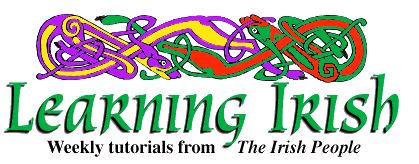
Irish Lesson 23
| PRONUNCIATION REVIEW Our next stage of pronunciation review covers the consonants "c" and "g". Irish consonants have two sounds, depending on whether the nearest vowel in the word is in the group of "a", "o", "u" or in the group of "e", "i". The explanation for this (which you need not remember) is that the "a, o, u" group sounds are formed farther back in the mouth than the "e, i" group sounds. The tongue and mouth positions for the two groups's sounds make it easier for a speaker to pronounce such adjacent letters as "c" and "g" in two different ways. This occurs in English speech, too, although it is not as extensive as in Irish. Notice how differently you pronounce the (k) sound in "king" and in "cold". The "k" in king is next to an "i", and it is natural for you to pronounce it differently from a "c" next to an "o". Now try exchanging the (k) sounds, pronouncing "king" with the (k) from "cold" and "coat" with the (k) from "king". The consonants adjacent to "a, o, u" vowels are called broad consonants. Slender consonants are near "e, i" vowels. The Irish sounds for "c" and "g" are much like the sounds you already know in English, and you can transfer the English sounds. Later, if you wish to make a minor improvement in your pronunciation of the slender "c" and "g", pronounce them with the tip of the tongue against the inside of the lower front teeth, which is probably slightly different from your English pronunciation. Here is a practice series of word groups. In each group, an English word comes first and contains the broad or slender (k) sound of the Irish word in the group. Call; cá (kaw*), where; cóta (KOH-tuh), coat; cúig (KOO-ig), five. King; cill (kill), cell; ceart (kart), right; cé (kay*), who. Cold; cos (kuhs), foot; cúpla (KOOP-luh), couple; cupán (ku- PAW*N), cup. Kettle; cinnte (KIN-te), certain; ceil (kel), conceal; cistin (KISH-tin), kitchen. Clod; cluas (KLOO-uhs), ear; clár (klaw*r), board; clois (klish), hear. Clip; clis (klish) fail; cliste (KLISH-te), clever; clé (klay*), left. Now try these words, making sure that you watch to see whether an "a, o, u" or an "e, i" vowel is nearest to the "c": clós (klohs); céad (KAY*-uhd); cara (KAH-ruh); ceist (kesht); clog (kluhg); cliste (KLISH-te) crua (KROO-uh); cré (kray*). A "g" is pronounced like a "c", except that the vocal cords are made to hum during the sound. To see how the two sounds of "g" are made, pronounce English "go" and "give". If the nearest vowel is "a, o, u" pronounce the "g" as in English "go". If the nearest vowel is "e, i", pronounce the "g" as in English "give". Try these: garda (GAHR-duh), guard; geata (GAT-uh), gate; gol (guhl), crying; géar (gay*r) sharp; glan (gluhn), clean; glic (glik), clever; grá (graw*), love; grian (GREE-uhn), sun. Our pronunciation guide usually does not indicate whether the consonants get their broad or slender sound. You must learn to watch for this yourself, noting the nearest vowel in the word. VOCABULARY Masculine Nouns buachaill (BOO-uhk*-il) boy capall (KAHP-uhl) horse cosán (kuh-SAW*N) sidewalk Feminine Nouns cluas, an chluas (KLOO-uhs, un K*LOO-uhs) ear bó, an bhó (boh, un vwoh) cow bán (baw*n) white gorm (GUH-ruhm) blue buí (bwee) yellow uaine (oo-IN-e) green (for cloth, etc.) dearg (DYAR-uhg) red dubh (doov) black glas (glahs) green (for grass) donn (doun) brown corcra (KOHR-kruh) purple GRAMMAR To use "tá" and "is" confidently, you must have a good idea of the conditions under which you use one or the other of these verbs. "Tá" tells where a person or object is and what it is doing (the verbal noun can follow "tá"). "Tá" also serves to describe a person or object by introducing adjectives. For examples of these usages: Tá sé anseo. He is here. Tá sé ag dul amach. He is going out. Tá sé fuar. It is cold. Select "is" when you want to say that a person or object is in a fairly permanent class, or when you want to identify a person or object as being the specific one about whom you are talking. Céard é seo? (kay*rd ay* shuh) What is this? is one question calling for "is". Is bosca é, or: is bosca beag é, are answers. Here are other examples: Is feirmeoir Seán (is fer-im-OH-ir shaw*n) John is a farmer. Is garda an fear sin, that man is a guard. Is fear mór Séamas, James is a big man. An Meiriceánach tú? Are you an American? Nach scoláirí sibhse? (nahk* skuh-LAW*-ree SHIV-she), arn't you students? Note the word order. What the person or thing is comes first, then the person or thing. To give a name to someone, or to say that a person of thing is the specific one, reverse the word order. Examples: Cé tusa? (kay* TU-suh), Who are you? Is míse Máirín. Ní míse Bríd. Cé hé sin? Who is that? Is é sin Brian. Ní hé sin Séamas. Cé hí seo? Who is this? Is í sin Máire. Ní hí seo Nóra. Is é seo mo nuachtán (shay* shuh muh NOO-uhk*-taw*n), this is my paper. Ní hé sin an nuachtán eile (nee hay* shin un NOO- uhk*-taw*n EL-e), that is not the other paper. Notice the difference in word order in: Is bord é sin, that is a table. Is é sin an bord (shay* shin un bohrd), that is the table. We will have more practice with this next week. (c) 1997 The Irish People. May be reprinted with credit. |